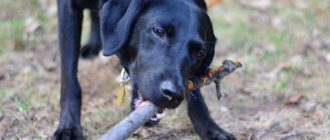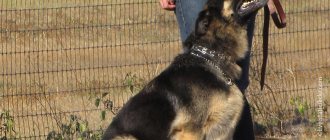“Apporter” is a French word, translated into Russian it means “to bring.” Practicing such skills involves the dog's natural instincts to chase and grab prey. Retrieving is part of OKD, the training of working dogs. A trained animal acts on command - it picks up an abandoned item, returns with it to the owner, and puts it in his hands. Exercise helps:
- train the sense of smell, hearing, vision;
- develop endurance;
- build a relationship between the action, gesture and voice of the owner;
- better orientation in space;
- release excess energy.
What is the “Aport” command used for?
It is completely clear why the commands “Come to me”, “Sit” or “No” are needed, for example. Why does a dog need to know the “Fetch” command, since it doesn’t seem to be that important? Let's consider why it is still worth teaching your pet to fetch various things:
- Running after a thrown object and bringing it back to the owner, the dog wastes its energy
[1]. In other words, this is an excellent training for the animal, prevention of obesity and diseases of the musculoskeletal system; - Teaching the “Fetch” command is not a routine, but a real game
[2], when the owner and his dog are on the same cheerful wavelength; - Executing the “Fetch” command is a great way to teach your dog to think logically
[1]. During the training process, the animal understands that it is required to first follow a thrown object, then take it in its teeth, and then return it to its owner. Exactly in this sequence; - It is worth teaching a dog to fetch various objects, if only so that the animal can control its own emotions
[1]. Of course, at first the pet will want to grab the toy and run away with it away from the owner, but over time he will understand that everything should go according to a plan clearly planned by the owner; - Dogs that have learned the “Fetch” command are well oriented in space
. They are able to clearly track the direction where a toy or other object was thrown; - Finally, a dog that knows the “Fetch” command very well can, if the owner wishes, be a real helper in the household
. So, your pet can be taught to fetch slippers or, for example, a newspaper.
Choosing a suitable toy for practicing the Fetch command
When purchasing a toy, consider your dog's age, size, and abilities. If your dog is older or younger, choose a toy that is easier to grasp with his teeth. If your dog is adept at returning toys to you, choose a toy that presents a more challenging task.
Here are some popular toys:
- Standard tennis ball
- Soccer balls or tennis balls
- Discs and flyers made of soft, flexible rubber—especially those that are extra gentle on sensitive mouths or designed to remain flexible in cold weather.
- Rope toys with rubber tips
- Plush Animal Shaped Dog Toys
Best time to practice
It is important that during training the dog is not too full and not too hungry. That is, at least 2 hours must pass after eating. The animal should not be sleepy and tired, otherwise it is unlikely to bring the owner a ball or any other thing. Of course, you should not train a pet that is not feeling well (poor appetite, weakness, digestive disorders, high fever, etc.).
In addition, what the animal’s mood is is of great importance. If your pet is angry, sad or overly excited, it is better to postpone training for a while. By the way, not only the attitude of the dog itself is important, but also that of its owner. You should not start training if your heart is not right. A bad mood will certainly be transmitted from a person to an animal.
Additional Tips for Playing Fetch
Use the power of speech
Dogs have an excellent ability to understand your words. When you consistently use certain phrases and actions together, your dog will quickly learn what behavior is required for each command.
Conquer boredom
Remember that even this exciting game will get boring for your dog after a while. Try introducing new challenges, such as holding your dog's collar when you throw a toy and making him wait for it to be picked up. You can even enter a "wait" command to tell them when it's time to do the search.
Give your dog treats as a reward
Treats and hugs are great ways to reinforce the behavior you want to encourage. Reward your dog for chasing the toy and for bringing it to you.
Take time to hug and pet your dog so he too knows how much you love playing fetch. Keep treats in your pocket for a nice surprise.
Run with your dog
If your dog is not a natural runner, then also run after the toy when you throw it. Your dog may not be able to resist running next to you. Praise your pet's efforts and continue to reward him with treats.
How to teach a dog to give you a toy?
Some dogs will fetch and even return the ball, but will not give it to you. They may be trying another game, hoping you'll chase them.
If this happens, use the “drop” command to encourage your dog to make the connection between specific words and what you want them to do. If you offer dogs a treat to throw a ball, they will often understand.
Practice with a ball in your hand
You can use the replay feature to take your dog's training one step further. Give an additional command, such as “give,” to have your dog put the ball in your hand instead of just dropping it on the ground.
You can also use this as an opportunity to teach your dog the "give" command, especially if he naturally throws the toy back to you. If they drop the toy early, start moving away from the dog before he drops it.
Where to conduct team training
You can teach your dog to fetch a toy both at home and outside. But it’s still better to spend the first week of classes in a room where no one and nothing can stop the dog from learning a new command. It will be better if there is no one in the room besides the owner and the animal itself. It is better to exclude any distracting sounds (working TV, radio, etc.) so that the dog is not distracted.
When the dog has mastered the “Fetch” command well enough within the room, it will have to be taken outside for training, giving preference to uncrowded and quiet places away from roads.
When and how to train
During training, the pet should be fed, not irritated and calm. The mood of the owner and the dog should be excellent. There is no need to force training. Training sessions are best carried out outdoors - this way the animal will not be disturbed by anything. However, if necessary, the dog can carry out the command in a spacious corridor.
It is recommended to start training at approximately 4 months of age. Younger pets cannot learn commands. It is possible to teach a similar command to adult dogs, although it will take a little more effort. The most favorable period for learning is the beginning of teething. Then the puppy will run after the stick with great pleasure.
What you will need for classes
To teach a dog the command “Fetch” or “Fetch”, you will need an object that can interest the animal.
[3].
This could be, for example, a rubber ball, a small rope, a small plastic bottle filled a quarter full of dry cereal, or a small Frisbee disc. The American Kennel Club advises dog owners to experiment with fetch items. The animal may be indifferent to new toys, but show interest in simple wooden sticks, which veterinarian Nicholas Jason does not recommend giving to dogs
[4], as they can cause injury to the pet.
In addition, you need to prepare treats
[3], which can be used as a reward. These can be store-bought delicacies, as well as cookies made from home-made meat, vegetables and grains, or oven-dried pieces of offal or lean meat fillet, pork ears or snouts.
To teach the “Fetch” command to a small puppy, at first it is advisable to use a collar and a long leash.
.
It also doesn’t hurt to use a clicker
[3] – a small device that makes a characteristic click that will tell the animal that it is doing everything right.
How to prepare for training
It is better to start training at 5-6 months, when the puppy has well mastered the basic commands from the general course: “come to me”, “next to me”, “sit”.
For training, find a place where there will be no distractions (strangers, cars and other dogs).
A leash and collar are an integral part of training, allowing the owner to teach the animal to be obedient and easily control it. The size of the collar is neck circumference + 2-3 cm (2 fingers of an adult can be placed between the harness and the dog’s skin). The length of the training leash is 5-25 m (depending on how much freedom you want to give your pupil). The cord should fit comfortably in your hand.
Classic fetch is an oblong-shaped toy made of wood, plastic and other durable, safe materials. If there is no such toy, the fetch item can be anything - a ball, an old glove, the main thing is to interest the pet.
To reward, choose a treat that your dog likes best.
Learning process
Teaching a dog to fetch a toy is not very difficult if you follow these simple rules:
- Give the dog the command “Sit”. The pet must have a collar and a long leash;
- Stand opposite the dog, taking the toy in your hand (by the way, you can teach the dog the “Fetch” command not only with the help of a toy, but also with other objects of suitable weight and size);
- You need to wait until the dog becomes interested in the thing in the owner’s hands. The dog should not just glance at her, but become interested. To do this, you can “revive” the toy a little (bring it closer to the animal’s nose, move it a little from side to side, etc.);
- As soon as the dog holds his gaze on the toy for a long time, you should click the clicker, praise the animal and treat it;
- The next step is contact between the dog and the toy. That is, the animal must take the toy in its teeth. As soon as this happens, the toy must be gently but persistently taken away, and then the dog must be rewarded (clicker, praise, treat). However, dogs do not always want to return the toy to the owner. In such situations, a treat can help. It is enough just to bring something tasty to the animal’s face and it will release the toy from its mouth;
- Afterwards, the toy must be “accidentally” dropped on the floor. The animal will most likely immediately pick up the fallen thing. You should use the clicker, praise the pet and say its name and the command “Fetch” (instead of the command “Fetch” you can say “Fetch”). The toy must be taken away from the dog;
- Now you need to throw the toy a short distance from the dog. Most likely, the animal will chase the thrown object and grab it;
- Immediately you need to lure the dog to you by simply calling it or giving the command “Come to me”;
- If the pet returns to the owner with a toy, he should be rewarded. If the dog does not want to bring the item to the owner, it will have to be gently pulled towards you using a leash;
- In the future, when the animal understands what the owner wants from it, it will be possible to get off the leash;
- As soon as the dog is nearby, you need to say the command “Give” and extend your hand to receive the toy. If there is no reaction, that is, the dog refuses to give the toy to the owner, you will have to make an exchange for a treat again;
- Again and again you need to repeat the previously mentioned steps: throw the toy, repeating the “Fetch” command, wait until the dog catches it, and then returns it to the owner’s hands. Each day of training, the distance from the dog to the thrown toy should increase slightly. React very emotionally every time when an animal performs a command correctly, as if some super significant event had happened. The animal must be sure that it is performing a truly important mission on the instructions of its beloved owner.
What should I do if my dog is not interested in this game?
If your dog doesn't understand how to fetch toys or seems uninterested in finding toys, start with a few basics:
- Introduce your dog to a tug of war toy.
- Add treats to the toy to make it more attractive.
- Tease your dog with a toy to get his attention.
Once the dog is interested in the toy, it's time to start playing fetch.
To begin, throw the toy a few meters away. As your dog catches you, be sure to show your enthusiasm so that he will want to please you by playing more. Gradually increase the distance you throw the toy until your dog understands how fun it is to chase something.
It is important to be patient during the learning process. If your dog doesn't understand the game as quickly as you want, hide any frustration you feel. Don't be discouraged if you have to pause and try again another day.
How to interest a dog?
With the right approach to an animal, the “fetch” command can become his favorite command. An interested dog will be very happy to retrieve an abandoned object, even if it doesn't like it.
The main thing is that the dog gets as much exercise as possible, since almost all dog breeds are very active and love to frolic, playing with their owner on the street. When she gets rid of accumulated energy, she becomes calmer and more obedient, and also amenable to training.
This will help her develop physical fitness, which is very important for a good purebred dog.











